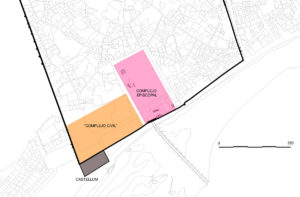
Urban Pattern
Roman Cordova reached its greatest extension towards the end of the second century and the beginnings of the third century, when there was a densification of intramural space and a growth phase of the different suburban neighborhoods (vici), which at that time reached their greatest development.

This image was altered from the second quarter of the third century, when the different suburban neighborhoods began to be abandoned and depopulated slowly and gradually. As a result, at the beginning of the fourth century, there is only evidence of domestic structures at certain points north and east of the city.
Such a withdrawal did not imply an increase in the density of the intramural space, where archaeological documentation attests to the abandonment of a growing number of public and private buildings which, at first (second half of the third century-early fourth century) abound in the area occupied by the theater and its environs, and that later (fourth and fifth centuries) are detected along the long and width of the intramural surface. The result was a less dense and cohesive occupation pattern characterized by the presence of three types of lots, including those occupied by public, semi-public and private buildings; those with urban solid waste, burials or with evidence of plundering, and others transformed into wastelands.

Although the archaeological record reveals the survival of the occupation in the upper part of the city. It is undoubted that the city gravitated towards its southern end, in search of elements such as the river, the port and the bridge. This circumstance allows to explain the installation in this point of the late antique power center, precedent of the later medieval power center (Alcazar and the Great Mosque).
Bibliography
CÁNOVAS, A. (2010): “La arquitectura doméstica de la zona occidental de Colonia Patricia Corduba”, en D. VAQUERIZO y J.F. MURILLO (eds.), El anfiteatro romano de Córdoba y su entorno urbano. Análisis arqueológico (ss. I-XIII d.C.). Monografías de Arqueología Cordobesa, nº 19 vol. II, Córdoba, 415-438.
JURADO, S. (2008): “El centro de poder de Córdoba durante la Antigüedad Tardía: origen y evolución”, Anales de Arqueología Cordobesa, nº 19, 203-230.
MURILLO, J.F. et alii (2009): “La manzana de San Pablo-Orive en el contexto de la evolución histórico-urbanística de la ciudad de Córdoba”, en Orive. La clave del espacio público en el Centro Histórico de Córdoba, Córdoba, 43-136.
RUIZ, M.D. (2016): Topografía, imagen y evolución urbanística de la Córdoba clásica a la tardoantigua (ss. II-VII d.C.). Tesis Doctoral (inédita), Córdoba.
VAQUERIZO, D.; MURILLO, J. F. (2010): “Ciudad y suburbia en Corduba. Una visión diacrónica (siglos II a.C.-VII d.C.)”, en D. VAQUERIZO (ed.), Las áreas suburbanas en la ciudad histórica. Topografía, usos y función. Monografías de Arqueología Cordobesa, nº 18, Córdoba, 455-522.
VARGAS, S. (2010): “El vicus del suburbium occidental de Colonia Patricia visto a través de sus conjuntos cerámicos”, en D. VAQUERIZO y J.F. MURILLO (eds.), El anfiteatro romano de Córdoba y su entorno urbano. Análisis arqueológico (ss. I-XIII d.C.). Monografías de Arqueología Cordobesa, nº 19, vol. II, Córdoba, 450-466.

